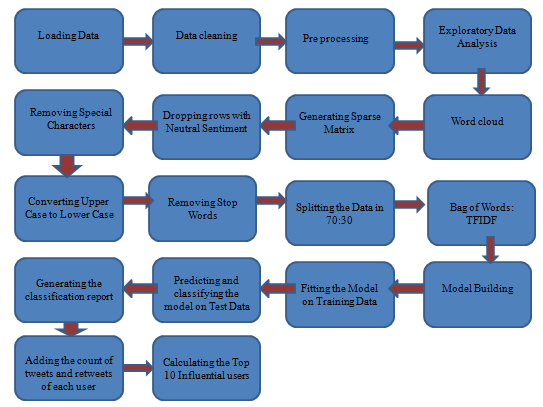Machine Learning Based Twitter Sentiment Analysis and User Influence
Main Article Content
Abstract
The use of social media platforms, such as Twitter, has grown exponentially over the years, and it has become a valuable source of information for various fields, including marketing, politics, and finance. Sentiment analysis is particularly relevant in social media analysis. Sentiment analysis involves the use of natural language processing (NLP) techniques to automatically determine the sentiment expressed in a given text, such as positive, negative, or neutral.
In this research paper, we focus on Twitter sentiment analysis and identify the most influential users in a given topic. We propose a methodology based on machine learning techniques to perform sentiment analysis and identify the most influential users on Twitter based on popularity. Specifically, we utilize a combination of NLP techniques, sentiment lexicons, and machine learning algorithms to classify tweets as positive, negative, or neutral. We then employ popularity calculations for each user to identify the top 10 most influential users on a given topic.
The proposed methodology was tested on a large dataset of US airlines tweets which is related to a specific topic i.e. airlines, and the results show that the approach can effectively classify tweets according to sentiment and identify the most influential users. We evaluated the performance of several machine learning algorithms, including Multinomial Naive Bayes, Support Vector Machines (SVM), Decision Trees, Gradient Boosting, logistic regression, AdaBoost, KNN and Random Forest, and found that the logistic regression algorithm has achieved the highest accuracy.
The proposed methodology has several implications for various fields, such as marketing, where sentiment analysis can help companies understand consumer behavior and tailor their marketing strategies accordingly. Moreover, identifying the most influential users can provide insights into opinion leaders in a given topic and help companies and policymakers target their messages more effectively.
Article Details
References
Essaidi, Abdessamad, Dounia Zaidouni, and Mostafa Bellafkih. "New method to measure the influence of Twitter users." 2020 Fourth International Conference On Intelligent Computing in Data Sciences (ICDS). IEEE, 2020.
Qi, Yuxing, and Zahratu Shabrina. "Sentiment analysis using Twitter data: a comparative application of lexicon-and machine-learning-based approach." Social Network Analysis and Mining 13.1 (2023): 31.
Bhatnagar, Sarvesh, and Nitin Choubey. "Making sense of tweets using sentiment analysis on closely related topics." Social Network Analysis and Mining 11.1 (2021): 44..
Gupta, Bhumika, et al. "Study of Twitter sentiment analysis using machine learning algorithms on Python." International Journal of Computer Applications 165.9 (2017): 29-34.
Hasan, Ali, et al. "Machine learning-based sentiment analysis for twitter accounts." Mathematical and computational applications 23.1 (2018): 11.
Pang, Bo, Lillian Lee, and Shivakumar Vaithyanathan. "Thumbs up? Sentiment classification using machine learning techniques." arXiv preprint cs/0205070 (2002).
Thomas Wilson, Andrew Evans, Alejandro Perez, Luis Pérez, Juan Martinez. Integrating Machine Learning and Decision Science for Effective Risk Management. Kuwait Journal of Machine Learning, 2(4). Retrieved from http://kuwaitjournals.com/index.php/kjml/article/view/208
Gautam, Geetika, and Divakar Yadav. "Sentiment analysis of twitter data using machine learning approaches and semantic analysis." 2014 Seventh international conference on contemporary computing (IC3). IEEE, 2014.
Mahato, M. K. ., Seth, S. ., & Yadav, P. . (2023). Numerical Simulation and Design of Improved Optimized Green Advertising Framework for Sustainability through Eco-Centric Computation. International Journal of Intelligent Systems and Applications in Engineering, 11(2s), 11–17. Retrieved from https://ijisae.org/index.php/IJISAE/article/view/2502
Navigli, Roberto. "Word sense disambiguation: A survey." ACM computing surveys (CSUR) 41.2 (2009): 1-69.
Joachims, Thorsten. "Text categorization with support vector machines: Learning with many relevant features." Machine Learning: ECML-98: 10th European Conference on Machine Learning Chemnitz, Germany, April 21–23, 1998 Proceedings. Berlin, Heidelberg: Springer Berlin Heidelberg, 2005.
Kanavos, Andreas, et al. "Emotional community detection in social networks." Computers & Electrical Engineering 65 (2018): 449-460.
Ding, Xiaowen, Bing Liu, and Philip S. Yu. "A holistic lexicon-based approach to opinion mining." Proceedings of the 2008 international conference on web search and data mining. 2008.
Khan, Farhan Hassan, Saba Bashir, and Usman Qamar. "TOM: Twitter opinion mining framework using hybrid classification scheme." Decision support systems 57 (2014): 245-257.
Krishna, Ragini, and C. M. Prashanth. "Identifying influential users on social network: an insight." Data Management, Analytics and Innovation: Proceedings of ICDMAI 2019, Volume 1. Springer Singapore, 2020.
Danisch, Maximilien, Nicolas Dugué, and Anthony Perez. "On the importance of considering social capitalism when measuring influence on Twitter." BESC 2014-International Conference on Behavioral, Economic, and Socio-Cultural Computing. IEEE, 2014.
Zhang, Yaocheng, et al. "MoSa: A modeling and sentiment analysis system for mobile application big data." Symmetry 11.1 (2019): 115.
Hansen, Lars Kai, et al. "Good friends, bad news-affect and virality in twitter." Future Information Technology: 6th International Conference, FutureTech 2011, Loutraki, Greece, June 28-30, 2011, Proceedings, Part II. Springer Berlin Heidelberg, 2011.
Tago, Kiichi, and Qun Jin. "Influence analysis of emotional behaviors and user relationships based on Twitter data." Tsinghua Science and Technology 23.1 (2018): 104-113.

